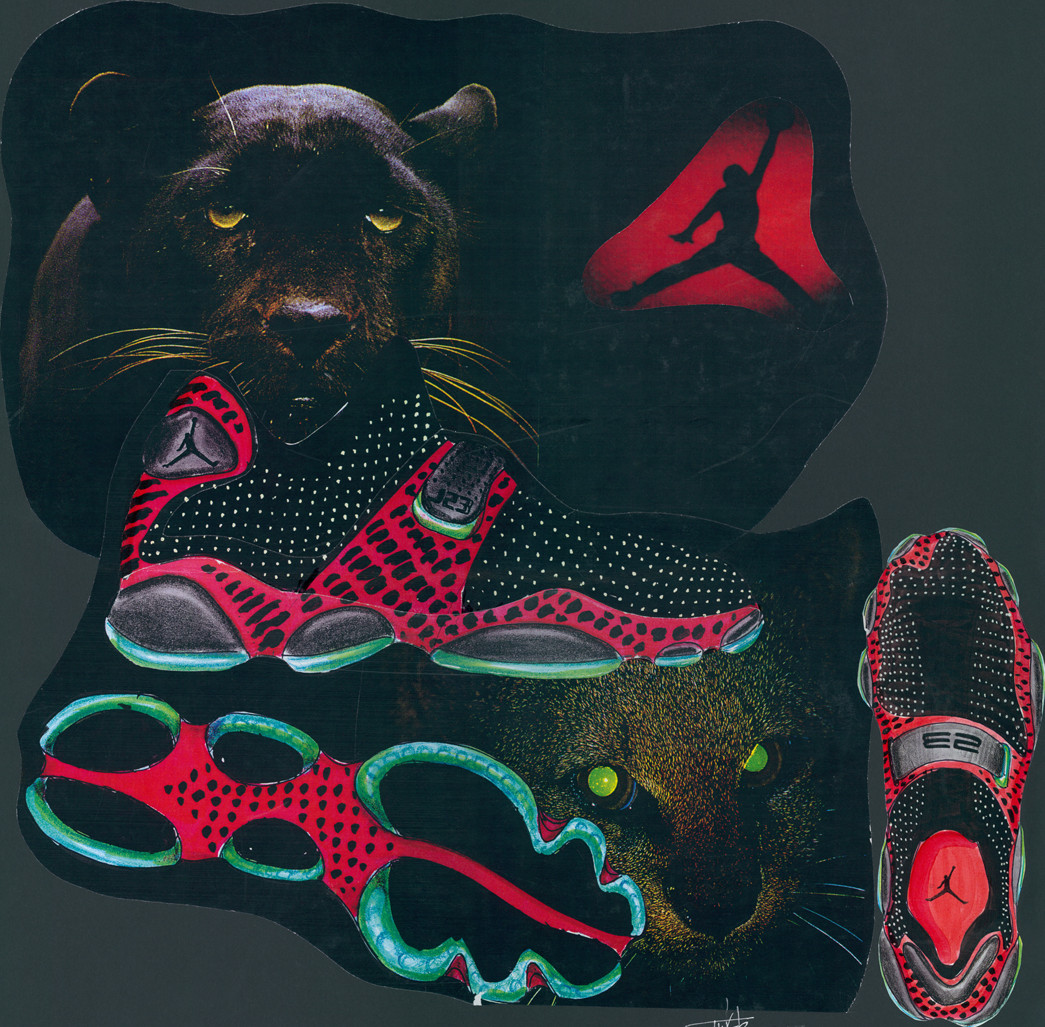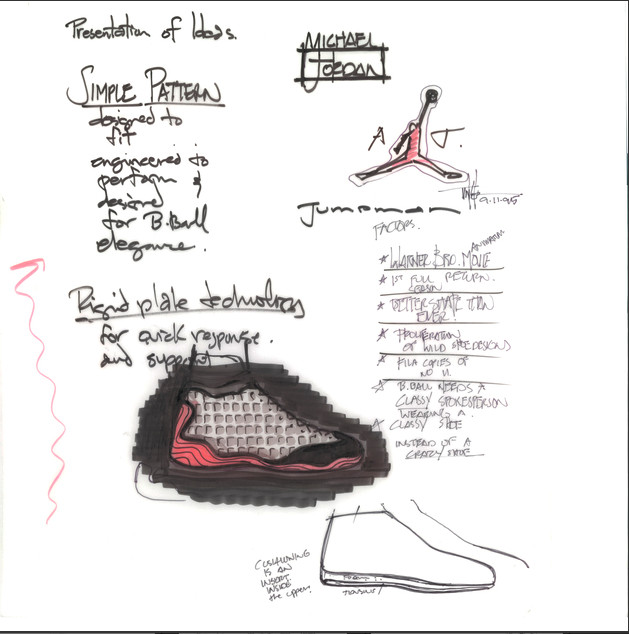“This shoe,” legendary designer Tinker Hatfield once recounted, “actually… it was quite an emotional moment when I presented the original concept to Michael.” The year was 1996, and Hatfield, already revered as a visionary in sneaker design, was tasked with creating the next signature shoe for Michael Jordan, the world’s most dominant basketball icon. However, inspiration seemed elusive, until a Bulls game on TV sparked an unexpected connection. Observing Jordan’s movements – his agility, his predatory instincts, his ability to conserve energy and strike with precision – Hatfield saw a feline, a black cat, in his play. This vision ignited a creative spark, leading to the birth of the Air Jordan 13 “Black Cat,” a sneaker steeped in stealth, innovation, and personal significance for Jordan himself.
 The original presentation board featuring the Air Jordan XIII ‘Black Cat’ concept that designer Tinker Hatfield showed Michael Jordan in 1996.
The original presentation board featuring the Air Jordan XIII ‘Black Cat’ concept that designer Tinker Hatfield showed Michael Jordan in 1996.
Original concept presentation board of Air Jordan 13 Black Cat, showcased by Tinker Hatfield to Michael Jordan in 1996, highlighting the shoe’s design and feline inspiration.
The “Black Cat” Inspiration: From Court Vision to Design Revelation
Tinker Hatfield’s design process for the Air Jordan 13 began not with sketches, but with observation. He watched Michael Jordan play, not just as a basketball player, but as an athlete embodying certain characteristics. Jordan’s on-court persona – intelligent, lithe, powerful, and instinctive – resonated with Hatfield as distinctly feline. This wasn’t just about agility; it was about the calculated, predatory nature of Jordan’s game, a silent hunter waiting for the opportune moment to attack. The “Black Cat” metaphor crystallized in Hatfield’s mind, providing a powerful and personal design direction.
Armed with this inspiration, Hatfield sketched his initial concepts, capturing the essence of the black cat in lines and forms. He then flew to Inglewood, California, where Jordan was filming the iconic “Frozen Moment” commercial. Behind the scenes, amidst the bustle of the set, Hatfield presented his design board for the Air Jordan XIII. Alongside detailed side and bottom views of the proposed shoe, he included illustrations of two black cats, their eyes glowing with intensity.
As Hatfield introduced the concept and uttered the words “Black Cat,” Jordan stopped him abruptly. “How did you know?” Jordan asked, surprised. He revealed that “Black Cat” was a secret nickname, used only by his closest friends. Hatfield, unaware of this personal connection, had tapped into something deeply resonant with Jordan, solidifying the design’s foundation on a shared, almost unspoken understanding. This serendipitous moment cemented the “Black Cat” concept as more than just an aesthetic theme; it became the soul of the Air Jordan 13.
Designing for Dominance: Performance Meets Black Cat Aesthetics
Beyond the evocative nickname, the “Black Cat” concept directly influenced the functional and aesthetic elements of the Air Jordan 13. Jordan, fresh off multiple championships and hungering for more, needed a shoe that could support his relentless pursuit of excellence. He demanded comfort, flexibility, superior court feel, and unwavering traction – features crucial for maintaining his speed and agility as opponents intensified their defense.
Hatfield translated these performance needs through the “Black Cat” lens. The outsole, a defining feature of the Air Jordan 13, was meticulously crafted to mimic the padded paws of a panther, providing exceptional grip and responsiveness. This panther-paw outsole wasn’t just a visual cue; it was engineered to enhance Jordan’s on-court movements, mirroring the feline’s agility and ground control.
Initially, Hatfield envisioned a mid-foot strap for added adjustability. Prototypes were even created with this feature. However, true to Jordan’s minimalist approach to performance, he tested the shoe and declared, “It doesn’t need a strap. Let’s not put anything on it that it doesn’t need.” Hatfield, respecting Jordan’s intuition and design philosophy, agreed, and the strap was removed, streamlining the design and focusing on essential performance elements. This decision reflected a core principle: every element of the Air Jordan 13 had to be purposeful, contributing to Jordan’s on-court dominance without unnecessary embellishments. The focus was on a “classy shoe,” as Hatfield noted, one that reflected Jordan’s sophisticated game and persona.
The Dawn of Digital Sneaker Design: Air Jordan 13 Leads the Way
The Air Jordan 13 marked a significant turning point in sneaker design history, becoming the first Air Jordan to be refined using computer technology. After the pivotal meeting with Jordan, Hatfield returned to Portland and faced the challenge of refining the intricate, cat-like details of the design. Traditional methods, relying on markers and tracing paper, proved cumbersome for achieving the level of detail he envisioned.
Recognizing the need for innovation, Hatfield enlisted Mark Smith from Nike’s graphics department. Together, they pioneered a new approach. Smith, proficient in digital design tools, sat at a Macintosh computer while Hatfield guided him, refining the sketches directly on screen using Adobe Illustrator and Photoshop. This collaboration broke new ground, streamlining the design process and allowing for unprecedented precision in realizing the “Black Cat” vision.
This digital revolution enabled them to perfect key aesthetic elements, such as the holographic “cat’s eye” on the heel and the reflective mesh side panels. The holographic eye, a striking detail, captured the piercing gaze of a cat, while the reflective mesh mimicked the subtle flecks of color within a black panther or leopard’s fur. These details, enhanced through digital design, elevated the Air Jordan 13 beyond a performance basketball shoe, transforming it into a visually captivating and conceptually rich piece of design. Hatfield himself acknowledged the pioneering nature of this process, recognizing the Air Jordan 13 as potentially the first shoe in the entire industry to leverage computer-aided design in such a significant way.
 Sept. 11, 1995 — designer Tinker Hatfield’s first sketch of the Air Jordan XIII.
Sept. 11, 1995 — designer Tinker Hatfield’s first sketch of the Air Jordan XIII.
Tinker Hatfield’s initial sketch of the Air Jordan 13 from September 11, 1995, showcasing early design concepts and notes for the iconic basketball shoe.
Jordan Brand is Born: Air Jordan 13 Takes Center Stage
1997 witnessed the monumental launch of Jordan Brand, a groundbreaking move by Nike that solidified Michael Jordan’s status not just as an athlete, but as a global brand. On September 9, 1997, Nike announced the creation of this subsidiary brand, dedicated to Jordan’s signature line and a new range of sportswear. This unprecedented step recognized Jordan’s immense influence and the burgeoning market for his products, estimated to generate over $225 million annually at the time.
The Air Jordan XIII was strategically chosen as the inaugural sneaker to launch under the newly formed Jordan Brand. This choice underscored the shoe’s significance and its embodiment of the brand’s core values: performance, innovation, and the seamless fusion of athlete and design. Tinker Hatfield, named Creative Director of Jordan Brand, articulated this vision in the launch press release, emphasizing that the Air Jordan XIII exemplified their approach of integrating Jordan’s performance needs and personality directly into the product.
Marketing for the Air Jordan XIII emphasized its lightweight construction – “the lightest Air Jordan ever made” – further highlighting its performance-driven design. As Jordan and the Bulls embarked on their quest for a third consecutive championship in the 1997-98 NBA season, the Air Jordan XIII became a prominent symbol on his feet, representing the pinnacle of basketball footwear and the dawn of the Jordan Brand era.
Enduring Legacy: The Timeless Appeal of the “Black Cat”
While the Air Jordan XIII may not be associated with a single, iconic “on-court moment” like some of its predecessors or successors, its legacy is undeniable. It wasn’t the shoe of “The Flu Game,” “The Last Shot,” or the free-throw line dunk. Yet, the Air Jordan 13 carved its place in sneaker history through its groundbreaking design, its deep connection to Michael Jordan’s persona, and its timeless aesthetic appeal.
The “Black Cat” design proved to be revolutionary, a departure from previous Air Jordans. Its unique silhouette, the panther-paw outsole, the holographic eye, and the reflective mesh all contributed to its distinctive identity. Despite initial nervousness from marketing and sales teams regarding its radical design, Michael Jordan embraced the Air Jordan 13 wholeheartedly, recognizing its performance benefits and its resonance with his “Black Cat” alter ego.
The enduring popularity of the Air Jordan 13, particularly the “Black Cat” colorway, is a testament to its timeless design. Decades after its original release, the “Black Cat” remains a sought-after sneaker, frequently re-released to meet continued demand. This enduring appeal underscores the success of Hatfield’s vision and the lasting impact of the Air Jordan 13 “Black Cat” as a true icon in sneaker culture, a symbol of stealth, innovation, and the unparalleled legacy of Michael Jordan.
Conclusion:
The Air Jordan 13 “Black Cat” is more than just a sneaker; it’s a story of inspiration, innovation, and the powerful synergy between a visionary designer and a legendary athlete. From Tinker Hatfield’s insightful “Black Cat” concept to the pioneering use of computer-aided design, and its pivotal role in launching Jordan Brand, the Air Jordan 13 “Black Cat” stands as a testament to creativity and performance. It remains an enduring icon, celebrated for its stealthy aesthetic, its groundbreaking design, and its indelible link to the legacy of Michael Jordan, the “Black Cat” himself.


